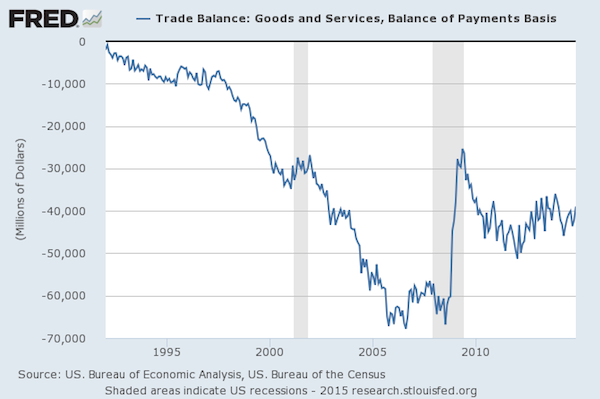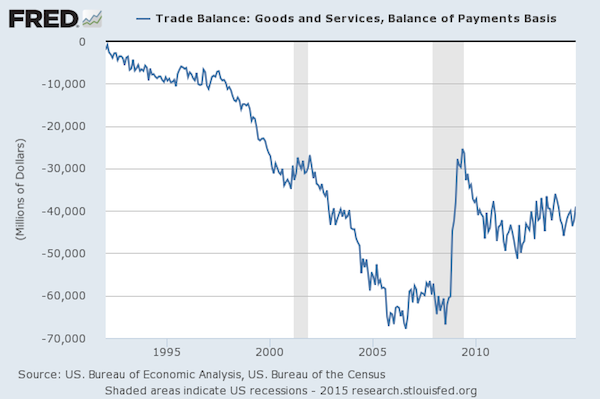U.S. trade deficit exceeds expectations to reach 11-month low


In November, the U.S. trade deficit beat expectations to hit an 11-month low. The balance of trade is how much the country imports from other countries versus how much it exports. When the former number is higher, there's a trade deficit. In November of 2014, that gap narrowed to $39 billion — from $42.2 billion that October — beating economists' expectations it would stick around $42 billion. The last time the deficit was this small was when it reached $37.4 billion in December of 2013, though the decrease is probably not enough to stop the deficit from being a drag on the economy.
America's exports actually dropped slightly in November, but imports fell even more, thanks largely to the dropping price of oil and the boom in domestic production. But there are also larger implications: when the U.S. dollar is stronger than other currencies, the trade deficit tends to increase, since it makes American exports more expensive. A trade deficit also means negative national savings by definition, which must be reflected in debt held either by Americans or by the federal government.
The modern trade deficit didn't actually appear until the 1980s, then closed in the early 1990s, and then expanded massively up until the Great Recession. Since then, it's fallen, but only slightly. --Jeff Spross
The Week
Escape your echo chamber. Get the facts behind the news, plus analysis from multiple perspectives.

Sign up for The Week's Free Newsletters
From our morning news briefing to a weekly Good News Newsletter, get the best of The Week delivered directly to your inbox.
From our morning news briefing to a weekly Good News Newsletter, get the best of The Week delivered directly to your inbox.

A free daily email with the biggest news stories of the day – and the best features from TheWeek.com
Jeff Spross was the economics and business correspondent at TheWeek.com. He was previously a reporter at ThinkProgress.
-
 The history of US nuclear weapons on UK soil
The history of US nuclear weapons on UK soilThe Explainer Arrangement has led to protests and dangerous mishaps
-
 Tea with Judi Dench: ‘touching’ show is must-watch Christmas TV
Tea with Judi Dench: ‘touching’ show is must-watch Christmas TVThe Week Recommends The national treasure sits down with Kenneth Branagh at her country home for a heartwarming ‘natter’
-
 Codeword: December 24, 2025
Codeword: December 24, 2025The daily codeword puzzle from The Week
-
 Nobody seems surprised Wagner's Prigozhin died under suspicious circumstances
Nobody seems surprised Wagner's Prigozhin died under suspicious circumstancesSpeed Read
-
 Western mountain climbers allegedly left Pakistani porter to die on K2
Western mountain climbers allegedly left Pakistani porter to die on K2Speed Read
-
 'Circular saw blades' divide controversial Rio Grande buoys installed by Texas governor
'Circular saw blades' divide controversial Rio Grande buoys installed by Texas governorSpeed Read
-
 Los Angeles city workers stage 1-day walkout over labor conditions
Los Angeles city workers stage 1-day walkout over labor conditionsSpeed Read
-
 Mega Millions jackpot climbs to an estimated $1.55 billion
Mega Millions jackpot climbs to an estimated $1.55 billionSpeed Read
-
 Bangladesh dealing with worst dengue fever outbreak on record
Bangladesh dealing with worst dengue fever outbreak on recordSpeed Read
-
 Glacial outburst flooding in Juneau destroys homes
Glacial outburst flooding in Juneau destroys homesSpeed Read
-
 Scotland seeking 'monster hunters' to search for fabled Loch Ness creature
Scotland seeking 'monster hunters' to search for fabled Loch Ness creatureSpeed Read
